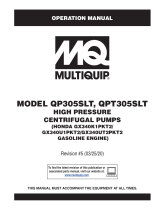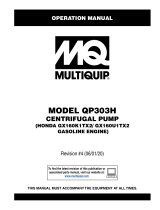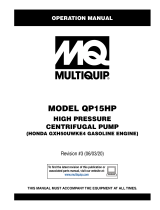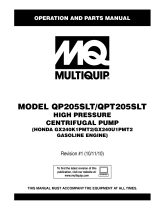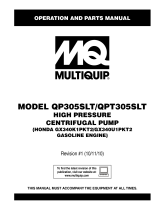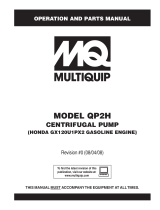Page is loading ...

PAGE 2 — QPT405SLT CENTRIFUGAL PUMP • OPERATION MANUAL — REV. #4 (06/10/20)
PROPOSITION 65 WARNING

QPT405SLT CENTRIFUGAL PUMP • OPERATION MANUAL — REV. #4 (06/10/20) — PAGE 3
TABLE OF CONTENTS
QPT405SLT
Centrifugal Pump
Proposition 65 Warning ........................................... 2
Table Of Contents .................................................... 3
Training Checklist .................................................... 5
Daily Pre-Operation Checklist ................................. 6
Safety Information ............................................. 7–11
Specifications/Dimensions ..................................... 12
General Information ............................................... 13
Components .................................................... 14–15
Inspection .............................................................. 16
Setup ..................................................................... 17
Operation ......................................................... 18–20
Maintenance .................................................... 21–25
Troubleshooting ............................................... 26–27
NOTICE
Specifications and part numbers are subject to change
without notice.

PAGE 4 — QPT405SLT CENTRIFUGAL PUMP • OPERATION MANUAL — REV. #4 (06/10/20)
NOTES

QPT405SLT CENTRIFUGAL PUMP • OPERATION MANUAL — REV. #4 (06/10/20) — PAGE 5
TRAINING CHECKLIST
Training Checklist
No, Description OK? Date
1
Read operation manual
completely
2
Machine layout, location of
components, checking of engine
and hydraulic oil levels
3 Fuel system, refueling procedure
4 Operation of spray and lights
5
Operation of controls (machine
not running)
6
Safety controls, safety stop switch
operation
7 Emergency stop procedures
8
Startup of machine, pre-heat,
engine choke
9 Forward and reverse travel
10 Starting a cut
11 Pavement cutting techniques
12 Stopping a cut
13
Restart after stopping blade within
work surface — explanation
14 Shutdown of machine
15 Lifting of machine (lift loops)
16 Machine transport and storage

PAGE 6 — QPT405SLT CENTRIFUGAL PUMP • OPERATION MANUAL — REV. #4 (06/10/20)
DAILY PRE-OPERATION CHECKLIST
Daily Pre-Operation Checklist
1 Hardware and damage check
2 Engine oil level
3 Hydraulic oil level
4 Condition of blade
5 Safety-stop switch operation
6 Braking control operation

QPT405SLT CENTRIFUGAL PUMP • OPERATION MANUAL — REV. #4 (06/10/20) — PAGE 7
SAFETY INFORMATION
Do not operate or service the equipment before reading
the entire manual. Safety precautions should be followed
at all times when operating this equipment.
Failure to read and understand the safety
messages and operating instructions could
result in injury to yourself and others.
SAFETY MESSAGES
The four safety messages shown below will inform you
about potential hazards that could injure you or others. The
safety messages specifi cally address the level of exposure
to the operator and are preceded by one of four words:
DANGER, WARNING, CAUTION
or NOTICE.
SAFETY SYMBOLS
DANGER
Indicates a hazardous situation which, if not avoided,
WILL result in DEATH or SERIOUS INJURY.
WARNING
Indicates a hazardous situation which, if not avoided,
COULD result in DEATH or SERIOUS INJURY.
CAUTION
Indicates a hazardous situation which, if not avoided,
COULD result in MINOR or MODERATE INJURY.
NOTICE
Addresses practices not related to personal injury.
Potential hazards associated with the operation of this
equipment will be referenced with hazard symbols which
may appear throughout this manual in conjunction with
safety messages.

PAGE 8 — QPT405SLT CENTRIFUGAL PUMP • OPERATION MANUAL — REV. #4 (06/10/20)
SAFETY INFORMATION
GENERAL SAFETY
CAUTION
NEVER operate this equipment without proper protective
clothing, shatterproof glasses, respiratory protection,
hearing protection, steel-toed boots and other protective
devices required by the job or city and state regulations.
NEVER operate this equipment when not
feeling well due to fatigue, illness or when
under medication.
NEVER operate this equipment under the infl uence of
drugs or alcohol.
NOTICE
This equipment should only be operated by trained and
qualifi ed personnel 18 years of age and older.
Whenever necessary, replace nameplate, operation and
safety decals when they become diffi cult read.
Manufacturer does not assume responsibility for any
accident due to equipment modifi cations. Unauthorized
equipment modifi cation will void all warranties.
NEVER use accessories or attachments that are not
recommended by Multiquip for this equipment. Damage
to the equipment and/or injury to user may result.
ALWAYS know the location of the nearest
fi re extinguisher.
ALWAYS know the location of the nearest
fi rst aid kit.
ALWAYS know the location of the nearest phone or keep
a phone on the job site. Also, know the phone numbers
of the nearest ambulance, doctor and fi re department.
This information will be invaluable in the case of an
emergency.
PUMP SAFETY
DANGER
NEVER
pump volatile, explosive, fl ammable or low fl ash
point fl uids. These fl uids could ignite or explode.
The engine fuel exhaust gases contain poisonous carbon
monoxide. This gas is colorless and odorless, and can
cause death if inhaled.
The engine of this equipment requires an adequate free
fl ow of cooling air. NEVER
operate this equipment in any
enclosed or narrow area
where free fl ow of the air is
restricted. If the air fl ow is
restricted it will cause injury
to people and property and
serious damage to the
equipment or engine.
NEVER operate the equipment in an explosive
atmosphere or near combustible materials. An
explosion or fi re could result causing severe
bodily harm or even death.
WARNING
NEVER
pump corrosive chemicals or water containing
toxic substances. These fl uids could create serious
health and environmental hazards. Contact local
authorities for assistance.
NEVER open the priming plug when pump
is hot. Hot water inside could be pressurized
much like the radiator of an automobile.
Allow pump to cool to the touch before
loosening plug. The possibility exists of
scalding, resulting in severe bodily harm.
NEVER disconnect any
emergency or safety devices.
These devices are intended for operator safety.
Disconnection of these devices can cause severe injury,
bodily harm or even death. Disconnection of any of these
devices will void all warranties.
DANGEROUS
GAS FUMES

QPT405SLT CENTRIFUGAL PUMP • OPERATION MANUAL — REV. #4 (06/10/20) — PAGE 9
SAFETY INFORMATION
CAUTION
NEVER lubricate components or attempt service on a
running machine.
NEVER block or restrict flow from discharge hose.
Remove kinks from discharge line before starting pump.
Operation with a blocked discharge line can cause water
inside pump to overheat.
NOTICE
ALWAYS fi ll the pump casing with water before starting
the engine. Failure to maintain water inside the pump
housing will cause severe damage to the pump and
mechanical seal.
In winter drain water from pump housing to prevent
freezing.
NEVER start the pump with the clean-out cover removed.
The rotating impeller inside the pump can cut or sever
objects caught in it. Before starting the pump, check that
the clean-out cover is securely fastened.
ALWAYS keep the machine in proper running condition.
ALWAYS ensure pump is on level ground before use.
Fix damage to machine and replace any broken parts
immediately.
ALWAYS store equipment properly when it is not being
used. Equipment should be stored in a clean, dry location
out of the reach of children and unauthorized personnel.
ENGINE SAFETY
WARNING
NEVER
operate the engine with heat shields or
guards removed.
DO NOT remove the engine oil drain plug
while the engine is hot. Hot oil will gush
out of the oil tank and severely scald any
persons in the general area of the pump.
CAUTION
NEVER touch the hot exhaust manifold,
muffl er or cylinder. Allow these parts to cool
before servicing equipment.
NOTICE
NEVER
run engine without an air fi lter or with a dirty air
fi lter. Severe engine damage may occur. Service air fi lter
frequently to prevent engine malfunction.
NEVER tamper with the factory settings
of the engine or engine governor. Damage
to the engine or equipment can result
if operating in speed ranges above the
maximum allowable.

PAGE 10 — QPT405SLT CENTRIFUGAL PUMP • OPERATION MANUAL — REV. #4 (06/10/20)
SAFETY INFORMATION
FUEL SAFETY
DANGER
DO NOT add fuel to equipment if it is placed inside truck
bed with plastic liner. Possibility exists of explosion or
fi re due to static electricity.
DO NOT start the engine near spilled fuel or combustible
fl uids. Fuel is extremely fl ammable and its vapors can
cause an explosion if ignited.
ALWAYS refuel in a well-ventilated area, away from
sparks and open fl ames.
ALWAYS use extreme caution when working with
fl ammable liquids.
DO NOT fi ll the fuel tank while the engine is running
or hot.
DO NOT overfi ll tank, since spilled fuel could ignite if it
comes into contact with hot engine parts or sparks from
the ignition system.
Store fuel in appropriate containers, in well-ventilated
areas and away from sparks and fl ames.
NEVER use fuel as a cleaning agent.
DO NOT smoke around or near the
equipment. Fire or explosion could result
from fuel vapors or if fuel is spilled on a
hot engine.
BATTERY SAFETY (ELECTRIC START ONLY)
DANGER
DO NOT
drop the battery. There is a possibility that the
battery will explode.
DO NOT expose the battery to open fl ames,
sparks, cigarettes, etc. The battery contains
combustible gases and liquids. If these
gases and liquids come into contact with a
fl ame or spark, an explosion could occur.
WARNING
ALWAYS wear safety glasses when
handling the battery to avoid eye irritation.
The battery contains acids that can cause
injury to the eyes and skin.
Use well-insulated gloves when picking up
the battery.
ALWAYS
keep the battery charged. If the battery is not
charged, combustible gas will build up.
DO NOT
charge battery if frozen. Battery can explode.
When frozen, warm the battery to at least 61°F (16°C).
ALWAYS
recharge the battery in a well-ventilated
environment to avoid the risk of a dangerous concentration
of combustible gases.
If the battery liquid (dilute sulfuric acid)
comes into contact with clothing or skin,
rinse skin or clothing immediately with
plenty of water.
If the battery liquid (dilute sulfuric acid) comes into
contact with eyes
, rinse eyes immediately with plenty
of water and contact the nearest doctor or hospital to
seek medical attention.
CAUTION
ALWAYS disconnect the
NEGATIVE battery terminal
before performing service on the equipment.
ALWAYS
keep battery cables in good working condition.
Repair or replace all worn cables.

QPT405SLT CENTRIFUGAL PUMP • OPERATION MANUAL — REV. #4 (06/10/20) — PAGE 11
TRANSPORTING SAFETY
CAUTION
NEVER allow any person or animal to stand underneath
the equipment while lifting.
NOTICE
Before lifting, make sure that the equipment parts (hook
and vibration insulator) are not damaged and screws are
not loose or missing.
Always make sure crane or lifting device has been
properly secured to the lifting bail (hook) of the
equipment.
ALWAYS shutdown engine before transporting.
NEVER lift the equipment while the engine is running.
Tighten fuel tank cap securely and close fuel cock to
prevent fuel from spilling.
Use adequate lifting cable (wire or rope) of suffi cient
strength.
Use one point suspension hook and lift straight upwards.
DO NOT lift machine to unnecessary heights.
ALWAYS tie down equipment during transport by
securing the equipment with rope.
ENVIRONMENTAL SAFETY
NOTICE
Dispose of hazardous waste properly.
Examples of potentially hazardous waste
are used motor oil, fuel and fuel fi lters.
DO NOT
use food or plastic containers to dispose of
hazardous waste.
DO NOT
pour waste, oil or fuel directly onto the ground,
down a drain or into any water source.
SAFETY INFORMATION

PAGE 12 — QPT405SLT CENTRIFUGAL PUMP • OPERATION MANUAL — REV. #4 (06/10/20)
Table 1. Specifications (Pump)
Pump
Model QPT405SLT
Type High Pressure Centrifugal Pump
Suction Size 4.00 in (102 mm)
Discharge Size
4.00 in (102 mm) 1 ea.
3.00 in (76 mm) 2 ea.
Maximum Pumping
Capacity
210 gpm/163 lbs/in²
Max. Lift 25 ft (7.6 m)
Max. Head 377 ft (115 m)
Dimension
(L x W x H)
36 x 27 x 31 in
(910 x 680 x 790 mm)
Dry Net Weight
311 lbs (141 kg)
Table 2. Specifications (Engine)
Engine
Model HONDA GX390UT2PXU
Type
Air-cooled 4 stroke, Single
Cylinder, OHV,
Horizontal Shaft, Gasoline
Engine
Bore x Stroke
3.46 in x 2.52 in
(88 mm x 64 mm)
Displacement 389 cm³
Max Output 11.8 hp/3,600 rpm
Fuel Tank Capacity
Approx. 1.59 U.S. gallons
(6 liters)
Fuel Unleaded Automobile Gasoline
Lube Oil Capacity 2-1/3 pints
Speed Control Method Centrifugal Flyweight Type
Starting Method Recoil Start
Dimension
(L x W x H)
15.9 x 18.1 x 17.6 in
(406 x 460 x 448 mm)
Dry Net Weight
55.1 lbs (25 kg)
SPECIFICATIONS/DIMENSIONS

QPT405SLT CENTRIFUGAL PUMP • OPERATION MANUAL — REV. #4 (06/10/20) — PAGE 13
Pump Support
The pump should always be placed in a level position on
solid, stationary ground. NEVER place the pump on soft
soil. The suction hose or pipe connection should always
be checked for tightness and leaks. A small suction leak
in the hose or fittings can prevent the pump from priming.
Elevation
Higher elevations will affect the performance of the pump.
Due to less atmospheric pressure at higher altitudes,
pumps do not retain the same priming ability they have
at sea level. This is caused by the “thinner air” or lack of
oxygen at higher altitudes.
A general rule of thumb is that for every 1,000 feet of
elevation above sea level, a pump will lose one foot of
priming ability.
For example, in Flagstaff, Arizona, where the elevation is
approximately 7,000 feet, the pump would have a suction
lift of only 18 feet rather than the 25 feet it would have at
sea level. Table 3 shows suction lift at various elevations.
Table 3. Suction Lift at Various Elevations
Altitude
in Feet
(Meters)
Suction Lift in Feet (Meters)
Sea Level 10.0 (3.048) 15.0 (4.572) 20.0 (6.096) 25.0 (7.620)
2,000 (610) 8.80 (2.680) 13.2 (4.023) 17.6 (5.364) 22.0 (6.705)
4,000 (1,219) 7.80 (2.377) 11.7 (3.566) 15.6 (4.754) 19.5 (5.943)
6,000 (1,829) 6.90 (2.103) 10.4 (3.169) 13.8 (4.206) 17.3 (5.273)
8,000 (2,438) 6.20 (1.889) 9.30 (2.834) 12.4 (3.779) 15.5 (4.724)
10,000 (3,048) 5.70 (1.737) 8.60 (2.621) 11.4 (3.474) 14.3 (4.358)
Table 4 shows percentage drops in performance as
elevation increases.
Table 4. Performance Loss at Various Elevations
Altitude in
Feet (Meters)
Discharge Flow Discharge Head
Sea Level 100% 100%
2,000 (610) 97% 95%
4,000 (1,219) 95% 91%
6,000 (1,829) 93% 87%
8,000 (2,438) 91% 83%
10,000 (3,048) 88% 78%
GENERAL INFORMATION
APPLICATION
The QPT405SLT centrifugal pump is a high pressure pump
designed to be used for dewatering applications. The suction
port on the QPT405SLT uses a 4-inch diameter opening.
There are three discharge ports on the pump—two are 3
inches in diameter, and the third is 4 inches in diameter.
This pump can discharge water at a rate of approximately
210 gallons/minute (gpm) or 795 liters/minute (lpm).
Centrifugal or self-priming pumps are designed to purge
air from the suction line and create a partial vacuum in the
pump body. The reduced atmospheric pressure inside the
pump allows water to flow through the suction line and into
the pump body. The centrifugal force created by the rotating
impellers pressurizes the water and assists in expelling it
from the pump discharge port(s).
Honda Engine
This centrifugal pump is powered by an 11.8-hp, air-cooled,
4-stroke, single-cylinder Honda GX390 gasoline engine
which incorporates an oil alert feature.
Oil Alert Feature
In the event of low oil or no oil, the Honda GX390 engine
has a built-in oil alarm and engine shutdown feature. When
the oil level is low, the engine will automatically shut down.
High Pressure Centrifugal Pump
High pressure centrifugal pumps provide powerful high head
and high psi performance. This type of pump supports many
applications, such as dust control, irrigation, equipment
washdown, fire fighting, and water jetting operations that
require high pressure discharge. The internal component
designs necessitate that this pump be used in clean water
operations, with no more than 10% solids-to-fluid ratios.
Suction Lift
This pump is intended for dewatering applications and is
capable of suction lifts of up to 25 feet at sea level. For
optimal suction lift performance, keep the suction hose or
line as short as possible. In general, always place the pump
as close to the water as possible.

PAGE 14 — QPT405SLT CENTRIFUGAL PUMP • OPERATION MANUAL — REV. #4 (06/10/20)
COMPONENTS (PUMP)
Figure 1 shows a typical application for the QPT405SLT centrifugal pump. Please note that this pump is intended for the
removal of clean water and water containing some debris and solids. DO NOT set a strainer on the bottom of the water bed.
Placing a strainer above the water bed will prevent the pump from drawing in excessive amounts of sand and foreign debris.
Figure 1. QPT405SLT Pump Application
1. Discharge Port (4-Inch) — Connect a flexible rubber
hose to this 4-inch discharge port on the pump. Make
sure that the hose lays flat and is not kinked. Use only a
recommended type discharge hose. Contact Multiquip
parts department for ordering information.
2. Discharge Port (3-Inch) —
Connect a flexible rubber
hose to these two 3-inch discharge ports on the pump.
Make sure that the hose lays flat and is not kinked. Use
only recommended type discharge hoses. Contact
Multiquip parts department for ordering information.
3. Fill Cap — Prior to operation, the pump casing should
be filled with water. Remove this cap to add water to
the pump. After the initial prime, a sufficient amount of
water will be retained in the casing so that the operator
will not need to re-prime later.
4. Mechanical Seal Oil Fill — For component protection
and optimum operating performance, the pump design
provides for a mechanical seal lubrication system. A
fill site gauge and fill port are co-located on the side
of the pump casing. Fill capacity is 250 cm³ (0.5 pint)
type ISO32 turbine oil.
5. Discharge Hose — Connect this flexible rubber
hose to the discharge port on the pump. Make sure
that the hose lays flat and is not kinked. Use only
recommended type discharge hose. Contact Multiquip
parts department for ordering information.
6. Pump — The QPT405SLT is a 4-inch high pressure
centrifugal pump and should only be used in clear
water applications (e.g. agricultural, industrial,
residential) as they have a limited solid-handling
capability of only 10% by volume.
7. Drain Plug — Remove this plug to drain water from
the pump.
8. Suction Hose — Connect this flexible rubber hose to
the suction port on the pump. Make sure that the hose
lays flat and is not kinked. Use only recommended type
suction hose. Contact Multiquip parts department for
ordering information.
9. Strainer — Always attach the strainer to the bottom
side of the suction hose to prevent large objects and
debris from entering the pump. The strainer should
be positioned so that it will remain completely under
water. Running the pump with the strainer above water
for long periods can damage the pump.

QPT405SLT CENTRIFUGAL PUMP • OPERATION MANUAL — REV. #4 (06/10/20) — PAGE 15
5. Recoil Starter — Manual starting mechanism. Slowly
pull the starter grip until resistance is felt, then pull
briskly and smoothly to start the engine.
6. Fuel Valve Lever — Open to allow the flow of fuel, and
close to prevent the flow of fuel.
7. Oil Drain Bolt — Remove to drain oil from the engine
crankcase.
8. Dipstick/Oil Filler Cap — Remove to determine
if engine oil is low. Add oil through this port as
recommended in Table 5.
9. Choke Lever — Aids in starting a cold engine, or
starting in cold weather conditions. The choke enriches
the fuel mixture.
10. Spark Plug — Provides spark to the ignition system.
Set the spark plug gap according to the engine
manufacturer's instructions, and clean the spark plug
once a week.
11. Muffler — Reduces noise and emissions. NEVER
touch the muffler while it is hot.
12. Air Cleaner — Prevents dirt and other debris from
entering the fuel system. Remove the wing nut on top
of the air cleaner to gain access to the filter elements.
CAUTION
NEVER disable or disconnect the engine ON/OFF
switch. It is provided for operator safety. Injury may
result if it is disabled, disconnected, or improperly
maintained.
WARNING
Engine components can generate
extreme heat. To prevent burns,
DO NOT touch these areas while the
engine is running or immediately after
operating. NEVER operate the engine
with the muffler removed.
NOTICE
Operating the engine without an air filter, with a
damaged air filter, or a filter in need of replacement
will allow dirt to enter the engine, causing rapid engine
wear.
Figure 2. Honda GX390 Engine Components
INITIAL SERVICING
The engine (Figure 2) must be checked for proper
lubrication and filled with fuel prior to operation. Refer to the
manufacturer's engine manual for instructions and details
of operation and servicing.
1. Throttle Lever — Adjusts engine RPM speed.
2. Fuel Filler Cap — Remove to add unleaded gasoline
to the fuel tank. Make sure cap is tightened securely.
DO NOT overfill.
3. Fuel Tank — Holds unleaded gasoline. Refer to
the manufacturer's engine manual for additional
information.
4. Engine ON/OFF Switch — ON position permits engine
starting, OFF position stops engine operation.
2
12
11
1
4
3
10
9
8
7
6
5
DANGER
DO NOT fill the fuel tank while the engine
is running or hot. In the event of a fuel
spill, DO NOT start the engine until all
fuel residue has been wiped up and the
area surrounding the engine is dry. Fuel
is extremely flammable and can ignite if
it comes into contact with hot engine parts
or sparks from the ignition system.
COMPONENTS (ENGINE)

PAGE 16 — QPT405SLT CENTRIFUGAL PUMP • OPERATION MANUAL — REV. #4 (06/10/20)
INSPECTION
BEFORE STARTING
1. Read the safety instructions at the
beginning of this manual.
2. Clean the pump, removing dirt and
dust—particularly the engine cooling
air inlet, carburetor, and air cleaner.
3. Check the air cleaner for dirt and dust. If the air cleaner
is dirty, replace with a new one as needed.
4. Check the carburetor for external dirt and dust. Clean
with dry compressed air.
5. Check fastening nuts and bolts for tightness.
ENGINE OIL CHECK
1. To check the engine oil level, place the pump on secure,
level ground with the engine stopped.
2. Remove the dipstick (Figure 3) from the engine oil filler
hole and wipe it clean.
Figure 3. Engine Oil Dipstick Removal
3. Insert and remove the dipstick without screwing it into
the filler neck. Check the oil level shown on the dipstick.
CAUTION
NEVER operate the pump in a confined
area or enclosed structure that does not
provide an ample free flow of air.
CAUTION
ALWAYS wear approved eye and
hearing protection while operating the
pump.
DIPSTICK
4. If the oil level is low (Figure 4), fill to the edge of the
oil filler hole with the recommended oil type (Table 5).
Maximum oil capacity is 1.16 quarts (1.1 liters).
Figure 4. Engine Oil Level
FUEL CHECK
1. Remove the fuel filler cap located on top of the fuel tank.
2. Visually inspect the fuel level. If fuel is low, replenish
with unleaded fuel
.
3. When refueling, be sure to use a strainer for filtration.
DO NOT top off fuel. Wipe up any spilled fuel
immediately.
UPPER LIMIT
LOWER LIMIT
Table 5. Oil Type
Season Temperature Oil Type
Summer 25°C or Higher SAE 10W-30
Spring/Fall 25°C–10°C SAE 10W-30/20
Winter 0°C or Lower SAE 10W-10
DANGER
Motor fuels are highly flammable and can
be dangerous if mishandled. DO NOT
smoke while refueling. DO NOT attempt
to refuel the pump if the engine is hot or
running.

QPT405SLT CENTRIFUGAL PUMP • OPERATION MANUAL — REV. #4 (06/10/20) — PAGE 17
5. The discharge hose is usually a collapsible (thin-walled)
hose. However, if a collapsible discharge hose is not
available, a rigid suction hose can be substituted in
its place.
6. Make sure the suction strainer is clean and securely
attached to the water end of the suction hose. The
strainer is designed to protect the pump by preventing
large objects from being pulled into the pump.
NOTICE
Suction and discharge hoses are available from
Multiquip. Contact your nearest dealer for more
information.
CAUTION
The strainer should be positioned so it will remain
completely under water. Running the pump with the
strainer above water for long periods can damage the
pump.
DANGER
DO NOT pump flammable fluids, corrosive chemicals,
or fluids containing toxic substances. These fluids can
create potentially dangerous health and environmental
hazards. Contact local authorities for assistance.
CAUTION
This pump uses a water-cooled mechanical seal
to prevent water from seeping into the engine. The
passage of water through the pump casing lubricates
the seal and prevents it from overheating. NEVER
operate the pump without water in the casing, as this
will cause damage to the mechanical seal.
BEFORE STARTING
1. Read the safety instructions at the
beginning of this manual.
2. Place the pump as near to water as
possible, on a firm, flat, level surface.
3. To prime the pump, remove the fill cap and fill the pump
casing with water. If the pump casing is not filled with
water prior to starting, it will not start pumping.
4. Check for leaks between the pump and the engine.
If water is leaking between the pump and engine
housing, the seal inside the pump may be worn or
damaged. Continued operation of the pump is not
recommended. Further usage of the pump under
these conditions may cause severe water damage to
the engine.
HOSES AND CLAMPS
1. Check that all hoses are securely attached to the
pump. Make sure the suction hose does not have any
air leakage. Tighten hose clamps and couplings as
required.
2. It is recommended that two clamps be used when
securing the suction hose to the inlet side of the pump.
3. Remember that suction hoses must be rigid enough to
not collapse while the pump is in operation.
4. Make sure the discharge hose is not restricted. Lay the
hose as straight as possible on the ground. Remove
any twists or sharp bends from the hose which may
block the flow of water.
CAUTION
The pump casing must be filled with water before
using the pump. Otherwise, the pump will not be able
to start pumping.
WARNING
DO NOT open the fill cap while the
pump is hot. Water inside may be under
pressure.
SETUP

PAGE 18 — QPT405SLT CENTRIFUGAL PUMP • OPERATION MANUAL — REV. #4 (06/10/20)
INITIAL START-UP
This section is intended to assist the operator with the initial
start-up of the pump. It is extremely important that this
section be read carefully before attempting to use the
pump in the field.
STARTING THE ENGINE
1. Place the engine fuel valve lever in the ON position
(Figure 5).
Figure 5. Engine Fuel Valve Lever (ON)
2. Move the throttle lever away from the SLOW position,
about 1/3 of the way toward the FAST position
(Figure 6).
Figure 6. Throttle Lever (1/3 Start Position)
CAUTION
DO NOT attempt to operate the pump until
the “Safety,” “General Information,” and
“Inspection” sections of this manual have
been read and thoroughly understood.
FUEL VALVE
LEVER
ON
OFF
THROTTLE
LEVER
FAST
SLOW
OPERATION
3. Place the choke lever in the OPEN position (Figure 7)
if starting a warm engine, or if the ambient temperature
is warm.
Figure 7. Engine Choke Lever (Open)
4. Place the choke lever in the CLOSED position (Figure
8) if starting a cold engine.
Figure 8. Engine Choke Lever (Closed)
5. Place the engine ON/OFF switch in the ON position
(Figure 9).
Figure 9. Engine ON/OFF Switch (ON)
OPEN
CLOSE
CHOKE LEVER
OPEN
CLOSE
CHOKE LEVER
ON
OFF
ENGINE SWITCH

QPT405SLT CENTRIFUGAL PUMP • OPERATION MANUAL — REV. #4 (06/10/20) — PAGE 19
OPERATION
6. Grasp the starter grip (Figure 10) and pull it slowly. The
resistance becomes strongest at a certain position,
called the compression point. Once this position is
reached, pull the starter grip briskly and smoothly to
start the engine.
Figure 10. Starter Grip
7. Once the engine has started, slowly return the choke
lever to the CLOSED position (Figure 11). If the engine
has not started, repeat steps 1 through 6.
Figure 11. Choke Lever (Closed)
8. Before the pump is placed into operation, run the
engine for several minutes. Check for fuel leaks and
any sounds that might indicate a loose component.
STARTER GRIP
OPEN
CLOSE
CHOKE LEVER
9. To begin pumping, place the throttle lever in the RUN
position (Figure 12).
Figure 12. Throttle Lever (Run)
THROTTLE
LEVER
FAST
SLOW
CAUTION
ALWAYS run the engine at full speed while pumping.

PAGE 20 — QPT405SLT CENTRIFUGAL PUMP • OPERATION MANUAL — REV. #4 (06/10/20)
OPERATION
STOPPING THE ENGINE
Normal Shutdown
1. Move the throttle lever to the IDLE position and run
the engine for three minutes at low speed (Figure 13).
Figure 13. Throttle Lever (Idle)
2. Place the engine ON/OFF switch in the OFF position
(Figure 14).
Figure 14. Engine ON/OFF Switch (OFF)
THROTTLE
LEVER
RUN
IDLE
ON
OFF
ENGINE SWITCH
3. Place the fuel valve lever in the OFF position
(Figure 15).
Figure 15. Fuel Valve Lever (OFF)
Emergency Shutdown
QUICKLY move the throttle lever to the IDLE position
(Figure 13) and place the engine ON/OFF switch in the
OFF position.
FUEL VALVE
LEVER
ON
OFF
/

